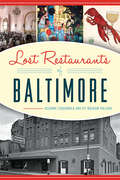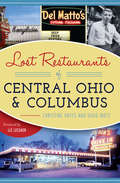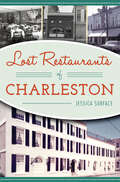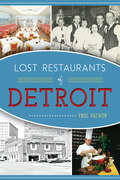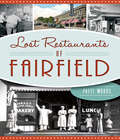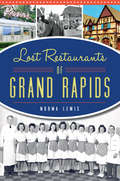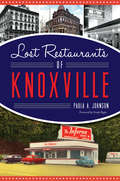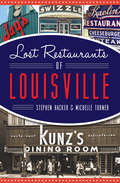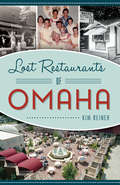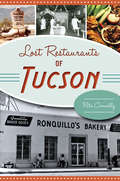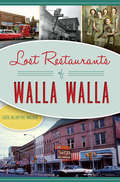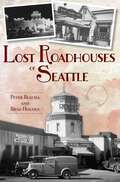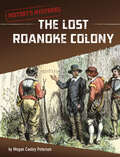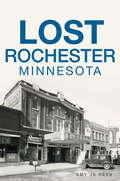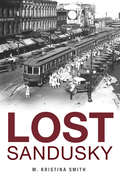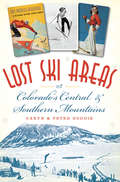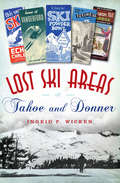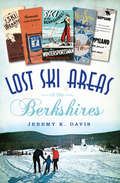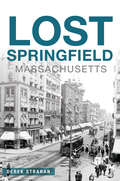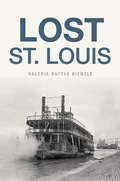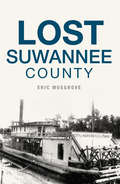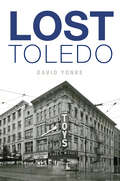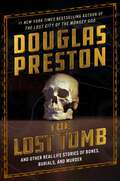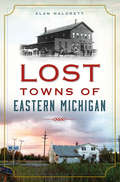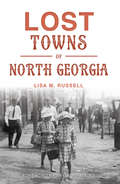- Table View
- List View
Lost Restaurants of Baltimore (American Palate)
by Suzanne Loudermilk Kim Watson PollardBaltimore's unforgettable dining scene of the past is re-visited here in thirty-five now shuttered restaurants that made their mark on this city.Haussner's artwork. Coffey salad at the Pimlico Hotel. Finger bowls at Hutzler's Colonial Tea Room. The bell outside the door at Martick's Restaurant Francais. Details like these made Baltimore's dining scene so unforgettable. Explore the stories behind thirty-five shuttered restaurants that Baltimoreans once loved and remember the meals, the crowds, the owners and the spaces that made these places hot spots. Suzanne Loudermilk and Kit Waskom Pollard share behind-the-scenes tales of what made them tick, why they closed their doors and how they helped make Baltimore a culinary destination.
Lost Restaurants of Central Ohio and Columbus (American Palate)
by Christine Hayes Doug Motz Liz LessnerFrom remote diners to downtown political havens, the restaurants of central Ohio satisfied palates for generations. In the era of Sunday drives before interstates, fabulous family-owned restaurants were the highlight of the trip. Sample the epicurean empires established by Greek, Italian, German and Chinese families. Recall the secrets of Surly Girl's chandelier, the delicious recipes handed down by chefs and the location of Flippo the Clown's former jazz hideaway. Following their previous book, Lost Restaurants of Columbus, authors Christine Hayes and Doug Motz deliver a second helping of unforgettable establishments that cemented central Ohio's reputation for good food and fun. That includes eighteen destination eateries in fifteen surrounding towns.
Lost Restaurants of Charleston (American Palate)
by Jessica SurfaceDiscover the culinary heritage of South Carolina&’s famous port city with this guide to historic restaurants that have come and gone. Once a sleepy city of taverns and coffeehouses, Charleston evolved into a culinary powerhouse of innovative chefs and restaurateurs. Jessica Surface, founder of Chow Down Charleston Food Tours, celebrates the city&’s rich cultural history in Lost Restaurants of Charleston. The origins of she-crab soup trace back through Everett&’s Restaurant. The fine dining of Henry&’s evolved from a Prohibition-era speakeasy. Desserts were flambéed from the pulpit of a deconsecrated church at Chapel Market Place, and Robert&’s hosted Charleston&’s famous singing chef. From blind tigers to James Beard Awards, Surface explores the stories and sites that give Charleston its unique flavor.
Lost Restaurants of Detroit (American Palate)
by Paul VachonThrough stories and recipes nearly lost to time, author Paul Vachon explores the history of the Motor City's fine dining, ethnic eateries and everything in between. Grab a cup of coffee - he's got stories to share.While some restaurants come and go with little fanfare, others are dearly missed and never forgotten. In 1962, patrons of the Caucus Club were among the first to hear the voice of an eighteen-year-old Barbra Streisand. Before Stouffer's launched a frozen food empire, it was better known for its restaurants with two popular locations in Detroit. The Machus Red Fox was the last place former Teamsters president Jimmy Hoffa was seen alive.
Lost Restaurants of Fairfield (American Palate)
by Patti WoodsThe culinary history of Fairfield, Connecticut, brims with bygone and beloved eateries and watering holes. Discover some of these lost classics, from the Sun Tavern--where George Washington enjoyed a few victuals--to the Scenario, where local celebrities always had a seat reserved at the bar. The best doughnuts in town were at the corner of Post and Beaumont at Devore's, while Art Green served up his famous chocolate cream pies at the Pie Plate. Join author Patti Woods for a generous serving of nostalgia complete with nachos from Sidetrack's, chili from Kuhn's and maybe even an ice cold beer from the Driftwood.
Lost Restaurants of Grand Rapids (American Palate)
by Norma LewisGrand Rapids restaurants have served up meals and memories since the city's earliest days. At Bentham's, one of the first downtown restaurants, customers without money to eat could trade an animal pelt for supper. John Sebaitis trained his German shepherd, Spooky, to serve beer to the patrons at his tavern. And a seventeen-year-old Gerald R. Ford worked part time as a server and dish washer at Bill's Place. Join Norma Lewis as she explores the history of Grand Rapids' most beloved eateries and the stories behind them.
Lost Restaurants of Knoxville (American Palate)
by Paula A. JohnsonOver the past 225 years, Knoxville dining has come full circle—from early taverns and saloons to upscale continental cuisine and back to the roots of local eating experiences. Greek immigrants Frank and George Regas founded the legendary Regas Restaurant, which operated for 90 years, spreading culinary influence throughout the entire city. Early country music stars frequented Harold’s Deli while visiting the city to perform on Tennessee’s first live radio shows. Guests from around the world sat 266 feet in the air at the Sunsphere Restaurant, a fine dining establishment run by the Hardee’s Corporation during Knoxville’s World’s Fair. Discover these and many more fascinating stories as author and historian Paula Johnson dives back in time through the stories of the city’s great restaurants.
Lost Restaurants of Louisville (American Palate Ser.)
by Stephen Hacker Michelle TurnerLouisville was home to fine cuisine long before the famous restaurant rows on Bardstown Road, Frankfort Avenue and East Market Street. Mazzoni's served the area's first rolled oyster. At the C-54 Grill, guests dined inside a remodeled aircraft, and Kaelin's prepared its classic cheeseburger. Hasenour's sauerbraten and Hoe Kow's war sui gai are two dishes that still make local mouths water when mentioned. Authors Stephen Hacker and Michelle Turner revisit the vivid personalities, celebrated spaces and unique recipes that made Louisville's historic eateries unforgettable.
Lost Restaurants of Omaha (American Palate)
by Kim ReinerOmaha is known for its beef, but the history of its most famous restaurants goes far beyond. The French Café was the place to go to celebrate. Piccolo Pete's, Mister C's and Bohemian Café helped shape neighborhoods in Little Italy, North Omaha and Little Bohemia. The tales of restaurateurs like the tragic Tolf Hanson; the ever-optimistic Ross Lorello; Anthony Oddo, once a resident at Boys Town; and Giuseppa Marcuzzo, a former bootlegger, also tell the story of the city. Restaurants played a prominent role as history unfolded in Omaha during prohibition, wartime rations, the fight for equal rights and westward expansion. Author Kim Reiner details the fascinating history behind Omaha's classic eateries.
Lost Restaurants of Tucson (American Palate)
by Rita ConnellyFrom western roadhouses to fine dining, Tucson boasts an extraordinary lineup of diverse restaurants. Though some of its greatest no longer exist, their stories conjure the sights, smells and sounds of the city's history. Longtime locals still buzz about Gordo's famous chimichangas, an accidental dish originating in Tucson. The legendary Tack Room was a beacon of fine dining. Places like Café Terra Cotta and Fuego pioneered a new southwestern cuisine, serving regional dishes like prickly pear pork and stuffed poblanos. University of Arizona alumni miss old spots like the Varsity, while long-gone haunts like Gus & Andy's attracted a unique crowd of businessmen, movie stars and the occasional mobster. Join local food writer Rita Connelly as she serves up savory stories of good food and good company from the gone but never forgotten favorites of the Old Pueblo.
Lost Restaurants of Walla Walla (American Palate)
by Catie McIntyre WalkerDining in Walla Walla blossomed from an influx of mining transplants in the late 1800s. Within decades, a roadhouse called the Oasis boasted a seventy-two-ounce slab of beef, and the old Pastime Café opened at 5:30 a.m. with white toast and whiskey for breakfast. In the early 1950s, Ysidro Berrones opened one of the valley's first Mexican restaurants, the El Sombrero Tortilla Factory and Café. Owner of Denney's Hi-Spot for two decades, Joe Denney also satisfied locals with his morning crooning to piano on KTEL. Native and local wine writer Catie McIntyre Walker celebrates this rich heritage with decades of departed, beloved establishments and the people behind them.
Lost Roadhouses of Seattle (American Palate)
by Peter Blecha Brad HoldenProhibition came early to Washington State--in 1916--and kicked off an unforgettable era of nightlife.Prohibition went national in 1920 and a network of roadside inns, taverns and dancehalls just outside of Seattle's city limits thrived well into the rockin' 1950s, providing illicit entertainment for those seeking a good time. Spurred on by early car culture and strict liquor laws, places like the Spanish Castle, The Jungle and The Black Cat sprang into being. Commonly called roadhouses, many of these remote outposts existed along two newly-built and parallel stretches of county highways - far from the prying eyes of city police. Fabled speakeasy operator, "Doc" Hamilton founded some of the earliest of these hideaways.Join authors Peter Blecha and Brad Holden as they uncover the fascinating era of forbidden nightclubs.
The Lost Roanoke Colony (History's Mysteries)
by Megan Cooley PetersonIn 1587, a group of about 115 English settlers arrived on Roanoke Island near North Carolina. They were there to establish an English colony. Later that year, the colony’s leader left the island to get supplies. His return trip was delayed. When he finally returned in 1590, the colony and its settlers were gone. What happened to the settlers? Explore the theories behind their disappearance and why it has become one of history’s greatest mysteries.
Lost Rochester, Minnesota (Lost)
by Amy Jo HahnRochester is synonymous with one of its most famous landmarks, the Mayo Clinic, but there's so much more to the Med City. It began as a frontier town, struggling to make its mark in a sparsely populated wilderness. By the late nineteenth century, Rochester had expanded into a vibrant city, rich with business, educational and cultural opportunities. Rediscover the Dubuque Trail and the beautiful summer lake retreats, along with the Cook Hotel, the Central Fire Station and more. Author Amy Jo Hahn uncovers the lost beginnings of Rochester and brings the stories of this unique place to life.
Lost Sandusky (Lost)
by M. Kristina SmithSANDUSKY BUILT ITS REPUTATION on the appeal of a picturesque lakefront and the opportunities of a manufacturing hub. Not only did its factories keep pace with the transportation industry, but the Ohio city also boasted the headquarters of international paper maker Hinde and Dauch and enough crayon production to be called the "Color Capital of the World." The amusement park at Cedar Point helped launch a new form of entertainment that continues today. But while the town remains a vacation destination and retains some heavy industry, it misses much of its former glory. Join M. Kristina Smith in revisiting those landmarks of Sandusky's past.
Lost Ski Areas of Colorado's Central and Southern Mountains
by Peter Boddie Caryn BoddieColorado's central and southern mountains still draw droves of skiers to the slopes. However, many of the historic runs and areas that were popular over the past century--some near the current resorts of Aspen, Breckenridge, Crested Butte, Purgatory, Telluride and Vail--no longer exist. Local hills like Whittaker Ranch near Eagle featured little more than a rope tow and warming hut. Now underneath Lake Dillon, Prestrud Jump hosted tournaments where Olympian Anders Haugen broke ski-jumping world records. From Lands End near Grand Junction to Sugarite near Trinidad, from swanky Hoosier Pass in Summit County to Stoner in Montezuma County, authors Caryn and Peter Boddie take readers on a tour of the lost ski areas of central and southern Colorado.
Lost Ski Areas of Tahoe and Donner
by Ingrid P. WickenAt the beginning of the twentieth century, Lake Tahoe and the Donner Summit region became California's first developed winter sports areas. Plentiful snowfall and newly built highways opened up the summer playground for visitors year-round, and skiing flourished. The Sierra Ski Club formed in 1925, attracting members eager to experience everything the mountains had to offer. People flocked to the slopes, visiting places like Clair Tappaan Lodge in Soda Springs, boasting one of the summit's earliest ski tows, and the Yuba Gap Lodge, a pioneer in night skiing. Join Ingrid P. Wicken, award-winning author and ski historian, as she recounts the fascinating beginnings of this celebrated ski hub.
Lost Ski Areas of the Berkshires (Lost)
by Jeremy K. DavisThe Berkshires of Massachusetts have long been known as a winter sports paradise. Forty-four ski areas arose from the 1930s to the 1970s. The Thunderbolt Ski Trail put the Berkshires on the map for challenging terrain. Major ski resorts like Brodie Mountain sparked the popularity of night skiing with lighted trails. All-inclusive resorts--like Oak n' Spruce, Eastover and Jug End--brought thousands of new skiers into the sport between the 1940s and 1970s. Over the years, many of these ski areas faded away and are nearly forgotten. Jeremy Davis of the New England/Northeast Lost Ski Areas Project brings these lost locations back to life, chronicling their rich histories and contributions to the ski industry.
Lost Springfield, Massachusetts (Lost)
by Derek StrahanAt the end of the nineteenth century, the U.S. Armory opened in Springfield, spurring rapid growth. With that golden age of progress came iconic buildings and landmarks that are now lost to time. Railroads brought workers eager to fill Springfield’s factories and enterprises like Smith & Wesson, Merriam Webster and Indian Motorcycles. The Massasoit House Hotel, the Church of the Unity and the Daniel B. Wesson mansion once served as symbols of the city’s grandeur. Forest Park grew into an upscale residential neighborhood of Victorian mansions. Join local historian Derek Strahan as he returns Springfield to its former glory, examining the people, events and—most importantly—places that helped shape the City of Firsts.
Lost St. Louis (Lost)
by Valerie Battle KienzleSt. Louis has been a shining beacon on the shores of the Mississippi River for more than 250 years, and many iconic landmarks have come and gone. The city hosted the World's Fair in 1904, with beautiful acres of buildings, gardens and fountains, nearly all of which are lost to time. Famous Busch Stadium now sits on an area that was once a vibrant community for Chinese immigrants. St. Louis Jockey Club was an expansive and popular gathering spot in the late nineteenth century until the state outlawed gambling. The Lion Gas Building was home to a unique mural featuring more than seventy shades of gray in tribute to famed aviator Charles Lindbergh. Author Valerie Battle Kienzle details the fantastic forgotten landmarks of St. Louis.
Lost Suwannee County (Lost)
by Eric MusgroveSuwannee County is filled with forgotten echoes of its lost past, from demolished pioneer homes to defunct railroads to lost forts from the Seminole Wars. In the 1830s, ecotourism arrived. Local sulfur springs, with their grand hotels and health resorts, drew travelers from around the world for a dip in the same healing waters of the Suwannee River traversed by steamboats. Thundering iron horses brought citizens and industry into the county, making Live Oak one of the largest cities in Florida in the early twentieth century. Landmarks and communities like the opulent Suwannee Springs resort and the once-flourishing riverbank town of Columbus disappeared in the face of progress. Lifelong resident and historian Eric Musgrove launches an entertaining and informative journey through Suwannee County’s lost history.
Lost Toledo (Lost)
by David YonkeLook back at some of the beloved places and landmarks in Toledo's past, from stores and stadiums to neighborhoods and nightclubs. Recall the birth of the Jeep, as well as unique shopping experiences at Tiedtke's, Lasalle's, Lamson's and Portside Festival Marketplace. Catch the action of a Toledo Mud Hens game at bygone ballpark Swayne Field. Watch the glittering marquees light up the downtown skyline once again with the names of performers ranging from Count Basie and Elvis Presley to B.B. King and KISS. Author David Yonke jogs fond memories in this nostalgic stroll through Toledo's heritage.
The Lost Tomb: And Other Real-Life Stories of Bones, Burials, and Murder
by Douglas PrestonDouglas Preston, the #1 bestselling author of The Lost City of the Monkey God, presents the jaw-dropping discovery of a vast Egyptian tomb containing dozens of sealed burial chambers, as well as recounting tales of pirate treasure, mysterious deaths, archaeological mysteries, and more… What&’s it like to be the first to enter an Egyptian burial chamber that&’s been sealed for thousands of years? Where might a blocked doorway or newly excavated corridor lead? And what might this stupendous tomb reveal about the most powerful pharaoh in Egyptian history? From the jungles of Honduras to macabre archaeological sites in the American Southwest, Douglas Preston's journalistic explorations have taken him across the globe. He broke the story of an extraordinary mass grave of animals killed by the asteroid impact that caused the extinction of the dinosaurs, he explored what lay hidden in the booby-trapped Money Pit on Oak Island, and he roamed the haunted hills of Italy in search of the Monster of Florence. When he hasn't been co-authoring bestselling thrillers featuring FBI Agent Pendergast, Preston has been writing about some of the world&’s strangest and most dramatic mysteries.The Lost Tomb brings together an astonishing and compelling collection of true stories about buried treasure, enigmatic murders, lost tombs, bizarre crimes, and other fascinating tales of the past and present.
Lost Towns of Eastern Michigan (Lost)
by Alan NaldrettMany of eastern Michigan's old boomtowns and sleepy villages are faded memories. Nature reclaimed the ruins of some while progress paved over the rest. Discover the stories of lost communities hidden in plain sight or just off the beaten track. The vanished religious colony of Ora Labora fell into a state of near-constant inebriation when beer became the only safe liquid to drink. Lake St. Clair swallowed up the unique currency of Belividere along with the place that issued it. Abandoned towns still crumble within Detroit's city limits. Alan Naldrett delves into the fascinating history of eastern Michigan's lost settlements.
Lost Towns of North Georgia (Hidden History)
by Raymond Atkins Lisa M. RussellWhen the bustle of a city slows, towns dissolve into abandoned buildings or return to woods and crumble into the North Georgia clay. The remains of numerous towns dot the landscape--pockets of life that were lost to fire or drowned by the water of civic works projects. In 1832, Auraria was one of the sites of the original American gold rush. Cassville was a booming educational and cultural epicenter until 1864. Allatoona found its identity as a railroad town. Author and professor Lisa M. Russell unearths the forgotten towns of North Georgia.
